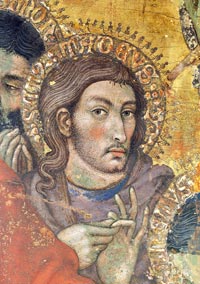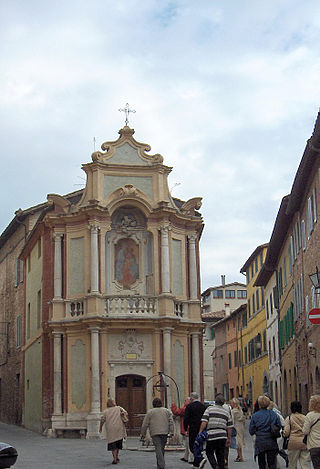
Jacopo di Mino del Pellicciaio (14th century) was an Italian painter, active in Siena.

Jacopo di Mino del Pellicciaio (14th century) was an Italian painter, active in Siena.
He worked in the middle of the 14th century in Siena and in the region of Umbria. Here he followed Simone Martini in his early years. His Madonna col bambino, also known as Madonna del cardellino, was painted around 1344 and can be admired in the church of San Martino in Foro in Sarteano. A coronation of the Virgin Mary (Incoronazione della Vergine, created around 1350) by him is in the Museo Civico di Montepulciano in Montepulciano. [1] A document from 1362 documents his collaboration with Bartolomeo Bulgarini and Luca di Tommè in work on the Maestà of Duccio di Buoninsegna. [2] Other known works can be found in Siena in the Basilica di San Clemente in Santa Maria dei Servi (Madonna del Belvedere, painted around 1363, could also be by Taddeo di Bartolo) [3] and in the Pinacoteca Nazionale di Siena (Crocifissione con San Francesco, Incoronazione di Santa Caterina d'Alessandria e santi and Madonna col bambino e i SS. Chiara, Giovanni Battista, Agostino, Francesco). In 1382 he received payments for work on the facade of the Baptistery of Siena Cathedral. [4] He was also active in Città della Pieve and Todi. [5]
He is also called Giacomo di Mino. He appears to be a follower of Simone Martini. He was the contemporary of Lippo Vanni and Luca Thome, being in 1373 appointed to value one of latter's pictures. His name appears in the Sienese records from 1362 to 1389. In 1367, he aided Bartolo di Maestro Fredi at the Siena cathedral. He is known to have painted book-covers for the Biccherna, and was several times a member of the Grand Council of Siena. He frescoed for the Basilica of San Francesco.
Milanesi mentions a Sienese painter 'Giacomo del Pellicciaio of the order of Friars Minor (Frate Minore). [6]

The Sienese School of painting flourished in Siena, Italy, between the 13th and 15th centuries. Its most important artists include Duccio, whose work shows Byzantine influence, his pupil Simone Martini, the brothers Pietro and Ambrogio Lorenzetti and Domenico and Taddeo di Bartolo, Sassetta, and Matteo di Giovanni.

Montepulciano is a medieval and Renaissance hill town and comune in the Italian province of Siena in southern Tuscany. It sits high on a 605-metre (1,985 ft) limestone ridge, 13 kilometres (8 mi) east of Pienza, 70 kilometres (43 mi) southeast of Siena, 124 kilometres (77 mi) southeast of Florence, and 186 kilometres (116 mi) north of Rome by car.

Domenico di Bartolo, born in Asciano, Siena, was a Sienese painter of the early Renaissance period. In the Lives of the Most Excellent Painters, Sculptors, and Architects, Giorgio Vasari says that Domenico was the nephew of Taddeo di Bartolo. Influenced by the new Florentine style of painting, Domenico di Bartolo was the only Sienese painter of his time to receive commissions from clients in Florence. In Siena, he was employed by Lorenzo di Pietro, to help execute the fresco The Care of the Sick, in the Pilgrim's Hall of the Hospital of Santa Maria della Scala.

Taddeo di Bartolo, also known as Taddeo Bartoli, was an Italian painter of the Sienese School during the early Renaissance. His biography appears in the Vite of Giorgio Vasari, who claims that Taddeo was the uncle of Domenico di Bartolo.
Sano di Pietro or Ansano di Pietro di Mencio (1405–1481) was an Italian painter of the Sienese school of painting. He was active for about half a century during the Quattrocento period, and his contemporaries included Giovanni di Paolo and Sassetta.

Matteo di Giovanni was an Italian Renaissance artist from the Sienese School.

Astolfo Petrazzi (1583–1665) was an Italian painter of the Baroque period, active mainly in his hometown of Siena, but also Spoleto and Rome. He was a pupil of mainly Francesco Vanni, but also worked under Ventura Salimbeni and Pietro Sorri. He died in Siena.

Luca di Tommè was an Italian painter active between 1356 and 1389 in Siena. He worked in the style established by earlier Sienese painters Duccio, Simone Martini, Pietro Lorenzetti and Ambrogio Lorenzetti. More than 50 works have been attributed to him. This large output contributed to the long-term survival of the decorative Sienese style well into the 15th century.
The decade of the 1330s in art involved some significant events.

The Pontifical Shrine of the Blessed Virgin of the Rosary of Pompei is a Roman Catholic cathedral, Marian pontifical shrine, and Pontifical minor basilica commissioned by Bartolo Longo, located in Pompei, Italy. It is the see of the Territorial Prelature of Pompei.

Andrea di Bartolo or Andrea di Bartolo Cini was an Italian painter, stained glass designer and illuminator of the Sienese School mainly known for his religious subjects. He was active between 1389–1428 in the area in and around Siena.

Cecco di Pietro was an Italian painter of the Pisan School. While his date of birth cannot be confirmed, there is some mention of a Cecco Pierri working with the painter Paolo di Lazzarino in 1350. If this was a reference to di Pietro, then his date of birth can be placed around 1330.

Niccolò di Buonaccorso, also Niccolò di Niccolò di Buonaccorso or Bonaccorso, was an Italian painter and one of the most prominent Sienese painters of the 14th century. The small body of his work that survives shows the artist's highly refined miniaturist technique. The artist was also briefly involved in local politics.

Santa Maria in Provenzano, or the Insigne Collegiata di Santa Maria in Provenzano, is a late-Renaissance-Baroque style, Roman Catholic, collegiate church in Piazza Provenzano Salvani, in the Terza Camollia, just southwest of the basilica of San Francesco, in the city of Siena, region of Tuscany, Italy. This Marian shrine was built around a 14th-century terracotta icon of the Madonna, which was credited with miracles. The Palio of Siena takes place on the day of veneration of this Marian devotion.

The Chapel of the Madonna del Rosario is a small, Baroque style, originally Roman Catholic, but now deconsecrated oratory or church located between via San Marco and via della Diana in the contrada of the Chiocciola (snail), in the city of Siena, Tuscany, Italy. It association with the neighborhood also gained the scenic building the name of the Chapel of the Chiocciola. The chapel is located some 200 meters west and uphill of Porta San Marco
Meo di Pero, also called Meo di Piero was an Italian painter active in Siena in a Gothic style. He worked in the studio of Cristoforo di Bindoccio. All the latter paintings are generally co-attributed to Meo, since no independent work is known.

Vincenzo Rustici was an Italian painter active in Siena. He was known for his religious compositions as well as his vedute showing public celebrations in Siena.

The Museo d'Arte Sacra della Val d'Arbia is a small museum of religious art in Buonconvento, in the Val d'Arbia to the south of Siena, in Tuscany in central Italy. It contain a number of paintings by important artists of the Sienese School, among them Duccio di Buoninsegna, Sano di Pietro and Pietro Lorenzetti. The museum is housed in the Palazzo Ricci Socini, close to the parish church of Santi Pietro e Paolo.

The Museo Civico di Montepulciano, also known as the Museo Civico Pinacoteca Crociani, is the town or comune art gallery and museum. It is housed in the medieval Palazzo Neri Orselli, a 14th-century structure located on Via Ricci #10, corner with Via Talosa, in the center of the town of Montepulciano, in the Province of Siena, region of Tuscany, Italy. The museum was founded in 1954.

The Bottini di Siena are a complex system of medieval underground aqueducts for the water supply of the city of Siena with a total length of 25 km. The system used to be the main water supply of the entire city of Siena until 1914 and nowadays continues to supply water to the fountains of Siena.